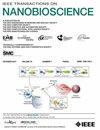Investigating Physical Layer Security in Molecular Communication Networks
IF 4.4
4区 生物学
Q1 BIOCHEMICAL RESEARCH METHODS
引用次数: 0
Abstract
In molecular communication networks, understanding the security level allows us to assess the quality of information transmitted accurately. The presence of unintended nodes in these networks is one of the factors compromising the security of information. This paper considers the simultaneous presence of a jammer and an eavesdropper as unintended nodes. This existence of unintended nodes prompts us to explore methods for assessing the security of a proposed system. Physical layer approaches can be regarded as one of the most efficient methods for assessing security in molecular communication networks. In this paper, we have utilized these approaches instead of the conventional cryptographic methods. At this layer, we have used several metrics to evaluate the security of our system; secrecy capacity (SC), the average probability of error (APOE), and comprehensive secure distance (CSD). By using SC, we also employed other approaches to improve security, such as changing the time interval, jamming molecules, and varying the distance between the transmitter and the receiver. As the last step, Monte Carlo simulation is used to verify the results obtained through analytical analysis.研究分子通信网络的物理层安全性。
在分子通信网络中,了解安全级别使我们能够准确地评估传输信息的质量。这些网络中意外节点的存在是危及信息安全的因素之一。本文将干扰者和窃听者同时存在视为非预期节点。这种非预期节点的存在促使我们探索评估所提议系统安全性的方法。物理层方法是评估分子通信网络安全性最有效的方法之一。在本文中,我们利用这些方法来代替传统的加密方法。在这一层,我们使用了几个指标来评估系统的安全性;保密能力(SC)、平均错误概率(APOE)和综合安全距离(CSD)。通过使用SC,我们还采用了其他方法来提高安全性,例如改变时间间隔,干扰分子,以及改变发射器和接收器之间的距离。最后一步,采用蒙特卡罗仿真对解析分析得到的结果进行验证。
本文章由计算机程序翻译,如有差异,请以英文原文为准。
求助全文
约1分钟内获得全文
求助全文
来源期刊

IEEE Transactions on NanoBioscience
工程技术-纳米科技
CiteScore
7.00
自引率
5.10%
发文量
197
审稿时长
>12 weeks
期刊介绍:
The IEEE Transactions on NanoBioscience reports on original, innovative and interdisciplinary work on all aspects of molecular systems, cellular systems, and tissues (including molecular electronics). Topics covered in the journal focus on a broad spectrum of aspects, both on foundations and on applications. Specifically, methods and techniques, experimental aspects, design and implementation, instrumentation and laboratory equipment, clinical aspects, hardware and software data acquisition and analysis and computer based modelling are covered (based on traditional or high performance computing - parallel computers or computer networks).
 求助内容:
求助内容: 应助结果提醒方式:
应助结果提醒方式:


